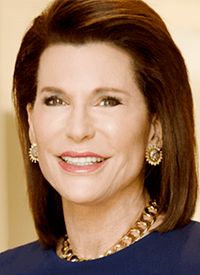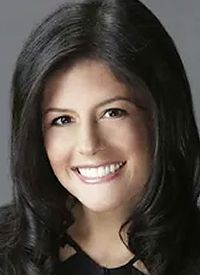Article
Miami Breast Keynotes Highlight the Call to Action for Advocacy Efforts in Breast Cancer
Author(s):
Lindsay Avner Kaplan and Nancy G. Brinker, the keynote speakers of the 40th Annual Miami Breast Cancer Conference, discuss the need to confront social determinants of health for patients and drive the public conversation and interpretation of personal and clinical stories in health care.
Nancy G. Brinker

There is a vast unmet need to confront not only the social determinants of health for patients, but the public conversation and interpretation of personal and clinical stories in health care. The Patti Hennessy Keynote Address and the Keynote Lecture delivered by Lindsay Avner Kaplan, founder and chief executive officer of Bright Pink, and Nancy G. Brinker, former United States Ambassador, and founder of The Promise Fund and Susan G. Komen for the Cure, focused on these 2 important topics during the 40th Annual Miami Breast Cancer Conference®.
Brinker Addresses the National Stage from Home
After 40 years launching, developing, and leading Susan G. Komen for the Cure, Brinker, in her now home state of Florida, set her sights on fixing a national issue through first developing in-state solutions to address disparities in care. “Our health care system is too complex for many people to even manage,” Brinker said. “For those with fewer resources, an otherwise treatable diagnosis of cancer can still be a death sentence. In my life, I’ve received a diagnosis of breast cancer beyond the breast cancer I had some years before, and [found out] that I was BRCA positive. I said to myself, ‘If we’re going to start making the kind of progress we need to make, we’ve got to double our work.’ Despite the years of background I had [in regard to] breast cancer and access to the best physicians, it was still terrifying.”
Brinker noted that efforts to uncover the local situation in her town of Palm Beach resulted in finding that approximately 80,000 to 100,000 women in Palm Beach County had no primary care provider and no specialty care provider. “Being a woman who receives a diagnosis and doesn’t have insurance, who has problems meeting her daily and weekly budget, who can’t speak English, and/or is the financial provider for family and can’t get time off—how could we expect them to want to be ambitious about finding out if they have a disease that they know they can’t afford [to treat]?” Brinker said. “For too many women when it comes to health care, [where they] live in America seems to make no difference.”
Brinker worked to develop The Promise Fund, a nonprofit organization that aims to reduce and prevent breast and cervical cancer by leveraging patient navigators, raising community awareness, building partnerships, and enacting policy changes.1 “For women already struggling with rent, poverty, childcare, and their own safety, health care seems like a luxury they can’t afford. These are the women we must help, and we are. The Promise Fund isn’t just a center for referrals; it’s a long-term systemic approach to laying a course for patients and their [caretaker] by providing them with a world-class navigator….We are creating a new health care system in our part of the state that we hope migrates all over the United States.”
Brinker noted that by choosing to partner with federally qualified health care center, FoundCare, The Promise Fund was afforded opportunity through grants and secured funding to open The Promise Fund Mammography Screening Center at FoundCare in West Palm Beach.2 In 2020, the center surpassed its goal of screening over 1000 patients in under 1 year. “Of those screened, more than 60 women across the Promise Fund of Florida Network have [received a] diagnosis of cancer. More than 80% of the cancer was detected in stages 0 to II, far earlier than the cancer would likely have been caught without the availability of the screening center,” a news release noted.2
Brinker noted that the reason the programs are seeing success is because, “The power of this approach is that it engages every level of the community. Besides scheduling appointments with the right specialists, we work with rideshare and transportation companies to ensure [patients] can get to their appointments on time. We will not quit. Nothing will push us away from helping a woman.”
From Patient to National News Story: Avner Kaplan Changes the Conversation
Lindsay Avner Kaplan

A headline captured from around the time that Avner Kaplan underwent a risk-reducing double mastectomy at what was then considered a young age reads “Becoming the Face of an Illness.” As word of her surgery spread and captured the attention of the media, Avner Kaplan and her surgeon, Patrick I. Borgen, MD, become public figures on risk-reduction surgery for patients with high-risk hereditary and genetic factors, such as a BRCA1 mutation.
“I went to college [and] graduated from the University of Michigan, and right before I was moving to Chicago to start a job in marketing, I ended up undergoing genetic testing,” Avner Kaplan explained in her chat with Borgen. “This was back in 2005, when I found out I had the BRCA1 genetic mutation… I often think of that 22-year-old who was at that moment about to launch into a whole new life, and then just reeling.” At the time, Avner Kaplan reached out to breast cancer survivorship organizations, but never quite felt as though she found the support she needed for this potential for a diagnosis. After enrolling in a high-risk screening program, where she would undergo scans every 6 months, Avner Kaplan said, “I kept thinking to myself, like, there isn't going to be a different way, but I can’t live like this forever.” From here, she found Borgen and their path toward the preventative surgery began.
“I believed back then, which is what I believe today, [that] this is a patient decision, not a doctor decision,” Borgen, chair of the Department of Surgery and head of the Maimonides Breast Center at the Maimonides Medical Center in the Bronx, New York, said. “The thing that we’ve learned since, especially about the mutation that [Avner Kaplan’s] family carries, is that the phenotype, the risk of getting cancer, is family dependent, not mutation dependent. And you'd already seen a number of women from 3 generations go through breast cancer. This was not a theoretical threat. This was a real threat. And the age became somewhat secondary to developing relationships with you, understanding you, and ultimately, after we got to know each other, supporting your decision.”
Avner Kaplan initially set out to tell her story even if it were to help only 1 person, but with the national attention, it soon became a criticism on her choice. However, that choice also led her on a new path. “There was a lot of criticism, and yet there was also the bright side of this, which was the impetus for me starting Bright Pink.”
Bright Pink, formerly an operating nonprofit, is a venture philanthropy fund. Through grants, Bright Pink is able to provide support for breast and ovarian health initiatives.3
In founding Bright Pink, Avner Kaplan focused on aiding individuals facing similar circumstance as she did. “I thought there are probably a lot of women in my same position,” Avner Kaplan said. “How can we create an organization that is focused on breast and ovarian health, and not cancer? How can we reach women when they’re healthy and just starting life? [How can we convey] all the research and impart this priority around knowing your risk and taking action?”
Avner Kaplan said that early adopters of digital technology helped to get Bright Pink to where it is today, having the reach of over 1.8 million women with information on breast and ovarian cancer risk. “Millions of women understand that breast cancer risk is not binary—it’s not as though these [individuals] have risk and others don’t—it exists on a continuum. I’m proud of that. I’m proud of the thousands of lives we’ve saved [known through] those who have reached out to us.”
References
- The Promise Fund. Nancy G. Brinker. Accessed March 4, 2023. https://nancybrinker.com/the-promise-fund/
- The Promise Fund Mammography Screening Center at FoundCare exceeds goal by screening more than 1000 patients in less than a year. FoundCare. Accessed March 4, 2023. foundcare.org/news
- Founding story. Bright Pink. Accessed March 4, 2023. https://brightpink.org/founding-story









